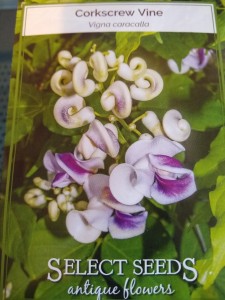 Thomas Jefferson collected many things, including plants. But there was one specimen that he could never lay hands on: Vigna caracalla or corkscrew vine. Writing to one of his plant suppliers, Jefferson described the flowering vine, a member of the legume or Fabiaceae family, as “the most beautiful bean in the world.”
Thomas Jefferson collected many things, including plants. But there was one specimen that he could never lay hands on: Vigna caracalla or corkscrew vine. Writing to one of his plant suppliers, Jefferson described the flowering vine, a member of the legume or Fabiaceae family, as “the most beautiful bean in the world.”
I think of the third president as I look at the seed packet on my desk. In it are the Vigna caracalla seeds that I will plant in the hopes of fulfilling Jefferson’s dream and raising at least one of the alluring vines.
Native to tropical areas, including parts of Mexico, Central America and Brazil, corkscrew vine grows not from a bean, but a tuber. It is an evergreen climber that boasts attractive, three-lobed leaves, but its real glory lies in the corkscrew or snail shell-like flowers. Slightly reminiscent of its relative, wisteria, the vine’s curling blooms are purple and white, aging to cream, and appear in upright racemes or flower clusters that can be as long as 12 inches. Corkscrew flowers are as fragrant as they are beautiful, attracting attention from humans, birds and butterflies from July through October.
Corkscrew vine has been known to gardeners for a long time, through centuries of cultivation and several name changes. It traveled from Brazil to Portugal late in the seventeenth century and was eventually named by Linnaeus, the eighteenth century father of plant taxonomy. Linnaeus called it “Phaseolus caracalla”, literally the “corkscrew bean”. In the twentieth century it was re-christened “Vigna caracalla”, in honor of a seventeenth century Italian botanist, Dominico Vigna. Most recently, it has been renamed yet again, and up-to-the-minute reference sources now refer to it as “Cochliasanthus caracalla”. “Cochlia” comes from a Latin root that denotes a spiraling, snail shell-like configuration. “Anthus”, also from a Latin root, means “flower”. Long before the vine acquired its latest, tongue-twisting name, it was sometimes commonly known as “snail vine”. Most sources still list it as Vigna caracalla.
Whatever it was called, corkscrew vine’s beauty and fragrance made it a hit with nineteenth century gardeners and, by the late Victorian era, florists. As the tides of horticultural fashion ebbed and flowed, it waxed and waned in popularity. Now it is back in vogue, and gardeners in search of unusual vertical accents are once again growing it in home gardens. Though Jefferson could never get his hands on corkscrew vine, it now flourishes at Monticello. Wherever he is, our first Gardener-in-Chief would undoubtedly be pleased.
Corkscrew vine is quite vigorous, once it gets going, but cultivation is not without its challenges. It is hardy in warm winter climates, so those of us who live elsewhere have to grow it in pots that can be moved indoors in winter, or resign ourselves to digging up and storing the tubers, as some people do with dahlias, cannas and other tropical beauties. A mature vine can reach 12 to 30 feet, with a spread of three to six feet, so a sturdy trellis, arbor or other support is necessary to give the twining stems something to grip. If you intend to grow it outdoors and bring the pot in for the winter, rest assured that you can cut the growth way back before moving the pot.
Since the vine takes time to get off the ground—literally and figuratively—I am going to start mine inside about eight weeks before the last frost date. In my area, USDA Zone 7a, where the last frost date is April 22, that means right now, around mid to late February. The seeds are relatively large and some authorities recommend nicking each one with a nail file before planting. Others suggest covering the seeds with boiling water and then letting them sit overnight in the same water prior to sowing. Either way, the objective is to make it easier for the sprout to penetrate the hard seed coat. I will probably use the boiling water method, or possibly try it both ways to see which seeds germinate first.
You can also plant the seeds outdoors about two weeks after the last frost date for your area. The Old Farmer’s Almanac features a handy tool that will calculate your last frost date by using your zipcode. Find it at https://www.almanac.com/gardening/frostdates.
Once outside, corkscrew vine needs a sunny spot and moist, well-drained soil. If you are growing it in a container, feed regularly with a balanced plant food, according to manufacturer’s directions and water when the top of the soil feels dry. This may be as often as once a day in very warm weather. Bring the pot indoors in the fall when night temperatures start falling into the fifties.
If Jefferson had been able to grow Vigna caracalla, he would undoubtedly have entered that fact in his garden book and shared seeds with his Virginia neighbors, not to mention his vast network of correspondents. We twenty-first century gardeners, with our internet access, have a much easier time getting seeds or plants. Seeds are available from Select Seeds, 180 Stickney Hill Road, Union, CT 06076-4617; (800) 684-0395; www.selectseeds.com. Plants are obtainable from the shop at Monticello, (800) 243-1743; www.monticelloshop.org.
